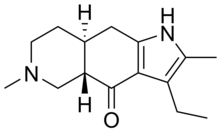ピキンドン
表示
 | |
| IUPAC命名法による物質名 | |
|---|---|
| |
| 臨床データ | |
| 法的規制 |
|
| データベースID | |
| CAS番号 |
78541-97-6 83784-19-4 (hydrochloride) |
| ATCコード | none |
| PubChem | CID: 121903 |
| ChemSpider | 108751 |
| UNII |
O1C9WXY65C |
| ChEMBL | CHEMBL1192678 |
| 化学的データ | |
| 化学式 | C15H22N2O |
| 分子量 | 246.35 g/mol |
| |
ピキンドン(Piquindone)は、1980年代に開発された三環式の非定型抗精神病薬であるが、市販されたことはない[1][2][3]。作用プロファイルに基づきその選択性には議論があるものの、選択的D2受容体アゴニストとして作用するとされている[4][5][6]。大部分の他のD2受容体リガンドと同様に、ピキンドンの結合性はN2依存を示す。この性質は、トロパピリド、ゼチドリン、メトクロプラミドと共通である[7]。
臨床試験においては、僅かに統計的有意性までには至らないものの、統合失調症の陽性症状及び陰性症状の治療にある程度の効果を持つ可能性が示された[1]。さらに、ハロペリドールと比較して、錐体外路症状や遅発性ジスキネジアの発生がかなり少ない[1][3]。精神病の他にも、ピキンドンはトゥレット障害にも効果を持つことが多くの臨床研究で示されている[8][9][10][11]。
関連項目
[編集]出典
[編集]- ^ a b c Cohen JD, Van Putten T, Marder S, Berger PA, Stahl SM (October 1987). “The efficacy of piquindone, a new atypical neuroleptic, in the treatment of the positive and negative symptoms of schizophrenia”. Journal of Clinical Psychopharmacology 7 (5): 324–9. doi:10.1097/00004714-198710000-00006. PMID 2890671.
- ^ Olson GL, Cheung HC, Morgan KD, et al. (September 1981). “A dopamine receptor model and its application in the design of a new class of rigid pyrrolo[2,3-g]isoquinoline antipsychotics”. Journal of Medicinal Chemistry 24 (9): 1026–34. doi:10.1021/jm00141a002. PMID 6116805.
- ^ a b Davidson AB, Boff E, MacNeil DA, Wenger J, Cook L (1983). “Pharmacological effects of Ro 22-1319: a new antipsychotic agent”. Psychopharmacology 79 (1): 32–9. doi:10.1007/BF00433013. PMID 6132425.
- ^ Nakajima T, Iwata K (November 1984). “[3HRo 22-1319 (piquindone) binds to the D2 dopaminergic receptor subtype in a sodium-dependent manner”]. Molecular Pharmacology 26 (3): 430–8. PMID 6149457.
- ^ Pugh MT, O'Boyle KM, Molloy AG, Waddington JL (1985). “Effects of the putative D-1 antagonist SCH 23390 on stereotyped behaviour induced by the D-2 agonist RU24213”. Psychopharmacology 87 (3): 308–12. doi:10.1007/BF00432713. PMID 2934758.
- ^ Molloy AG, O'Boyle KM, Pugh MT, Waddington JL (July 1986). “Locomotor behaviors in response to new selective D-1 and D-2 dopamine receptor agonists, and the influence of selective antagonists”. Pharmacology, Biochemistry, and Behavior 25 (1): 249–53. doi:10.1016/0091-3057(86)90262-5. PMID 3529126.
- ^ Collin S, Vercauteren DP, Vanderveken D, Evrard G, Durant F (March 1989). “Structural requirements of Na+-dependent antidopaminergic agents: Tropapride, Piquindone, Zetidoline, and Metoclopramide. Comparison with Na+-independent ligands”. Journal of Computer-aided Molecular Design 3 (1): 39–53. doi:10.1007/BF01590994. PMID 2715795.
- ^ Uhr SB, Berger PA, Pruitt B, Stahl SM (October 1984). “Treatment of Tourette's syndrome with RO22-1319, a D-2-receptor antagonist”. The New England Journal of Medicine 311 (15): 989. doi:10.1056/NEJM198410113111517. PMID 6147753.
- ^ Uhr SB, Pruitt B, Berger PA, Stahl SM (April 1986). “Case report of four patients with Tourette syndrome treated with piquindone, a D2 receptor antagonist”. Journal of Clinical Psychopharmacology 6 (2): 128–30. doi:10.1097/00004714-198604000-00028. PMID 2871057.
- ^ Uhr SB, Pruitt B, Berger PA, Stahl SM (July 1986). “Improvement of symptoms in Tourette syndrome by piquindone, a novel dopamine-2 receptor antagonist”. International Clinical Psychopharmacology 1 (3): 216–20. doi:10.1097/00004850-198607000-00004. PMID 3549873.
- ^ Jiménez-Jiménez FJ, García-Ruiz PJ (2001). “Pharmacological options for the treatment of Tourette's disorder”. Drugs 61 (15): 2207–20. doi:10.2165/00003495-200161150-00005. PMID 11772131.
